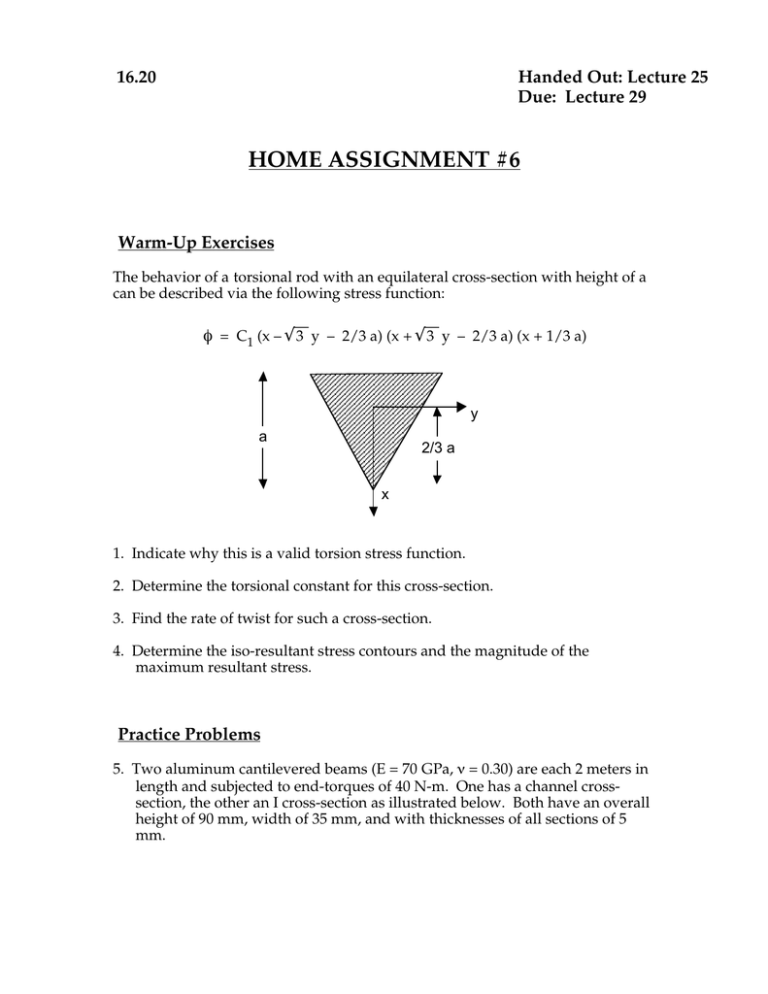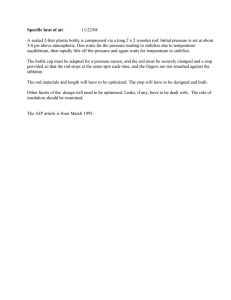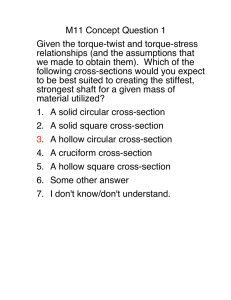HOME ASSIGNMENT #6 Lecture 25 16.20 Handed Out: Lecture 29
advertisement

Handed Out: Lecture 25 Due: Lecture 29 16.20 HOME ASSIGNMENT #6 Warm-Up Exercises The behavior of a torsional rod with an equilateral cross-section with height of a can be described via the following stress function: — — φ = C1 (x – √ 3 y – 2/3 a) (x + √ 3 y – 2/3 a) (x + 1/3 a) y a 2/3 a x 1. Indicate why this is a valid torsion stress function. 2. Determine the torsional constant for this cross-section. 3. Find the rate of twist for such a cross-section. 4. Determine the iso-resultant stress contours and the magnitude of the maximum resultant stress. Practice Problems 5. Two aluminum cantilevered beams (E = 70 GPa, ν = 0.30) are each 2 meters in length and subjected to end-torques of 40 N-m. One has a channel crosssection, the other an I cross-section as illustrated below. Both have an overall height of 90 mm, width of 35 mm, and with thicknesses of all sections of 5 mm. 16.20 Home Assignment #6 Fall, 2002 Page 2 5 mm 5 mm 90 mm 5 mm 5 mm 5 mm 5 mm 35 mm 35 mm For the two beams, determine and compare: (a) The angle of twist, α, (in degrees) between the two endfaces. (b) The maximum resultant shear, τ, developed (assume possible stress concentrations near corners have been relieved by adequate fillets). ? 5 mm 90 mm 5 mm (c) A T-section of the same height of 90 mm is also being considered in this case. What length would the top of the “T” need to have in order for the resistance to torsion be the same as for the channel section? As for the I crosssection? All pieces continue to have a thickness of 5 mm. Application Tasks 6. A four-foot long aluminum (E = 10.5 Msi, ν = 0.30) rod has an elliptical crosssection, as shown with a major axis, 2a, of 5 inches and a minor axis, 2b, of 2 16.20 Home Assignment #6 Fall, 2002 Page 3 inches. The rod is subjected to a torque of magnitude 150 ft-lbs at its end. The behavior of a rod with an elliptical cross section can be described using the torsion stress function: φ = A (x2/a2 + y2/b2 – 1) y x 2b 2a (a) Determine the torsional constant, J, for this cross-section. (b) Find the angle of twist, α, between the two endfaces of the rod. (c) Find the location and value of the maximum shear stress in the rod. (d) Determine the warping displacement of any section of the rod. (e) Consider the two cases of the rod being made of steel (E = 30 Msi, ν = 0.30) and being made of titanium (E = 15.5 Msi, ν = 0.34). Determine the answers for (a) through (d) in these cases. (f) For the two cases of a steel rod and a titanium rod, find the elliptical dimensions (for the same ratio of a/b) necessary to have a structure with the same torsional rigidity as the aluminum rod. Find the location and maximum shear stresses for these cases. (g) Using the answers of (a) through (f) and using the density of the three materials (aluminum = 0.097 lbs/in3, steel = 0.283 lbs/in3, titanium = 0.170 lbs/in3) and their respective yield stresses (aluminum = 68 ksi, steel = 105 ksi, titanium = 172 ksi), remark on the efficiency and capability of the various materials in transmitting stress. Use this to indicate what groups of material variables are important in evaluating torsional capability.




